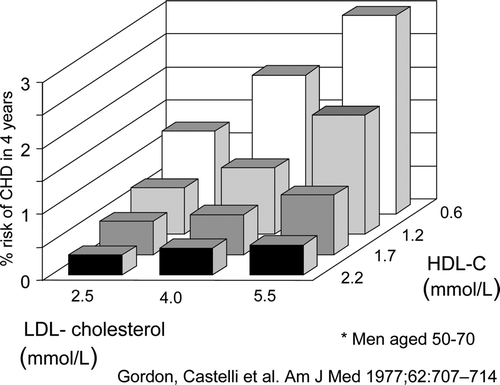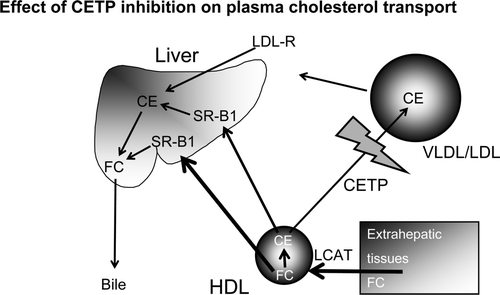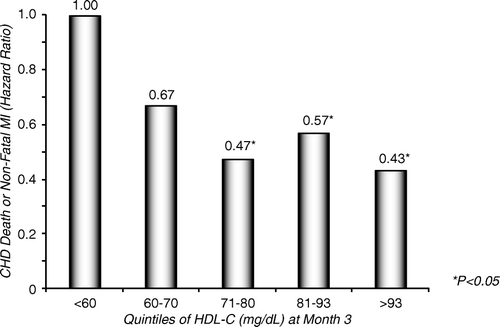Figures & data
Figure 1. Four-year coronary heart disease risk in men aged 50–70 years according to HDL and LDL cholesterol concentrations at base-line in the Framingham study Citation5.

Figure 2. CETP inhibition. By blocking the transfer of cholesterol esters from HDL to VLDL/LDL the cholesterol content of HDL increases and that of VLDL/LDL decreases. (CE = cholesteryl ester; CETP = cholesteryl ester transfer protein; FC = free cholestrol; LCAT = lecithin cholesteryl acyl transferase, SR-B1 = scavenger receptor B1). By courtesy of Professor Philip Barter, Sydney.

Figure 3. Data from the ILLUMINATE trial. Post-hoc exploratory analyses in the torcetrapib/atorvastatin group hazard ratios for CHD death or non-fatal myocardial infarction by quintile of on-trial HDL cholesterol (referent group is HDL cholesterol <60 mg/dL stratum). Cox proportional hazard model adjusted for age, gender, and base-line HDL-C. In spite of the overall negative outcome of the ILLUMINATE trial the figure demonstrates a significant negative relation between on-trial HDL cholesterol and CHD death + non-fatal myocardial infarctions. By courtesy of Dr P Barter, AHA 2007. Unpublished.

Figure 4. Risk estimates for subgroups of HDL-C in IDEAL and EPIC-Norfolk studies. A: In IDEAL the relationships of HDL-C with major coronary event were calculated by a Cox proportional hazards model, yielding values for relative risk for a 1-SD increase of HDL-C with 95% confidence intervals. The basic regression model included covariates for age, gender, and smoking status (current, former, never) recorded at base-line. B: In EPIC-Norfolk, the relationships of HDL-C with major coronary events were determined by conditional logistic regression analysis that took into account the matching for age, gender, and enrolment period and included the covariates smoking status (current, former, never), body mass index, and alcohol consumption (number of units per week). The major coronary event risk estimates were expressed as odds ratios for a 1-SD increase of HDL-C with 95% confidence intervals. EPIC = European prospective investigation of cancer; IDEAL = Incremental decrease in endpoints through aggressive lipid lowering; MCE = major coronary event.

